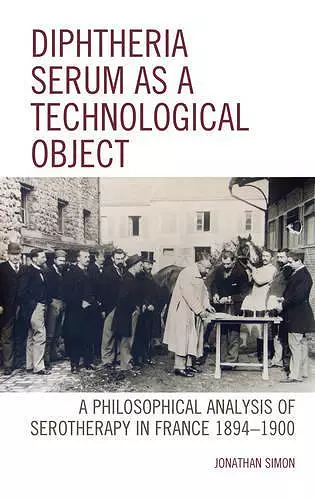Diphtheria Serum as a Technological Object
A Philosophical Analysis of Serotherapy in France 1894-1900
Format:Hardback
Publisher:Lexington Books
Published:27th Dec '16
Currently unavailable, and unfortunately no date known when it will be back

Introduced in 1894 as a treatment for a deadly childhood disease, the diphtheria serum stands as a milestone in pharmaceutical history. Diphtheria Serum as a Technological Object: A Philosophical Analysis of Serotherapy in France 1894-1900 considers the production and use of this serum in France, analyzing the drug in terms of a technological object. To do this, Jonathan Simon draws on the philosophy of technology, exploring the application of this approach to medical drugs and suggesting how such an analysis can in turn contribute to this domain of philosophy. Starting with the manufacture of the serum from horses’ blood, Simon then considers the processes involved in transforming the blood serum into a legal medical drug and establishing its efficacy as a treatment against diphtheria. The book looks at the place the drug assumed in French society at the time, as well as the legal and political implications of its manufacture and use. All these elements are deployed to characterize a specifically French serum, as the author argues that the constitution of the drug in its full sense is not only technical but also social, political, and legal. Considering the serum as technological object facilitates a philosophical reflection on the nature of medical drugs in general by means of a thorough analysis of this particular historical example. The insights offered in this book will be of interest to students and scholars working on the philosophy of technology, particularly the medical sciences, as well as to historians of medicine, particularly those interested in the history of pharmacy.
Diphtheria Serum as a Technological Object is a succinct book examining a pharmaceutical innovation and its dispersal and circulation across borders. It is clearly written and argued and merits inclusion in research libraries as well as in graduate seminars on the history of medicine, French institutional history, and the history of technology. It will also appeal to those interested in the scholarly turn toward object-based ontologies and how this perspective can illuminate pharmaceutical history. * H-France Review *
Although Simon’s approach is avowedly drawn from the philosophy of technology, his study enriches our historical understanding of the history of the diphtheria antiserum in refreshing and unexpected ways. In their effect on human bodies, medicines are, after all, as much technological objects as scalpels and syringes, and this understanding gives Simon’s study originality and message. From his account of how the serum was made using the blood of specially selected and cared-for horses, through to his masterly analysis of how the serum was inserted into France’s political economy as an instrument of revenge on German medical science for defeat in the Franco-Prussian War, this is no standard history of drug development. * Bulletin of the History of Medicine *
With his in-depth study of the history of diphtheria antiserum in France, Simon makes an original and valuable contribution to the History and Philosophy of Science, Technology and Medicine. Building on his own extensive and highly regarded earlier work on the history of chemistry and pharmacy, Simon convincingly shows that medicines such as diphtheria antiserum are more than just material objects. They are special technological objects, given form and sense by the context in which they are adopted in and the many roles they fulfill, in return shaping the societies in which they are deployed. The relatively short time-frame (1894-1900) as well as the single national context chosen for his study allow Simon not only to perform a synchronic slice across different spaces, but to engage with philosophical issues about the nature of technology whilst developing a sophisticated and original methodological framework for doing so. -- Viviane Quirke, Oxford Brookes University
ISBN: 9781498531474
Dimensions: 239mm x 159mm x 16mm
Weight: 445g
168 pages